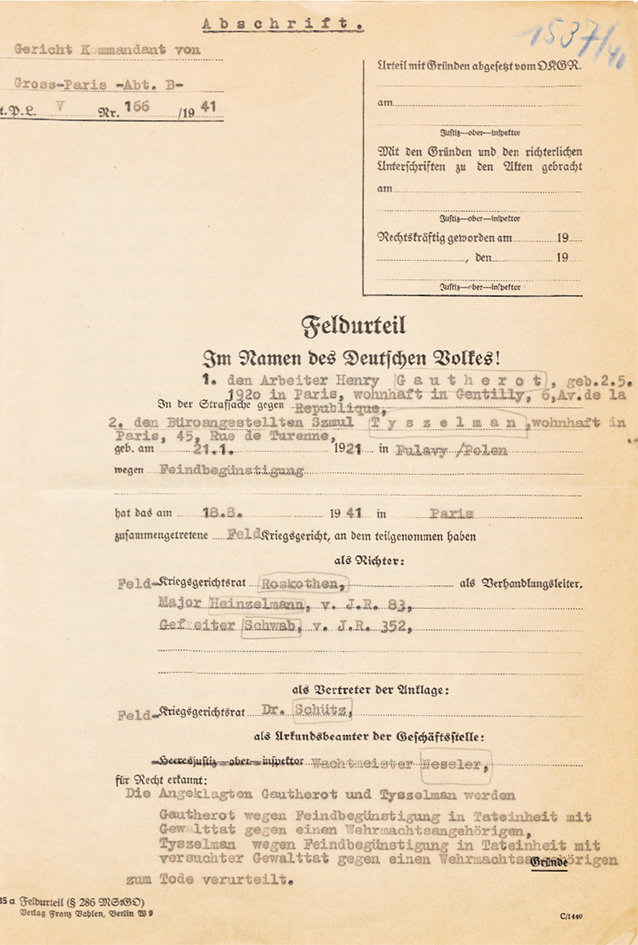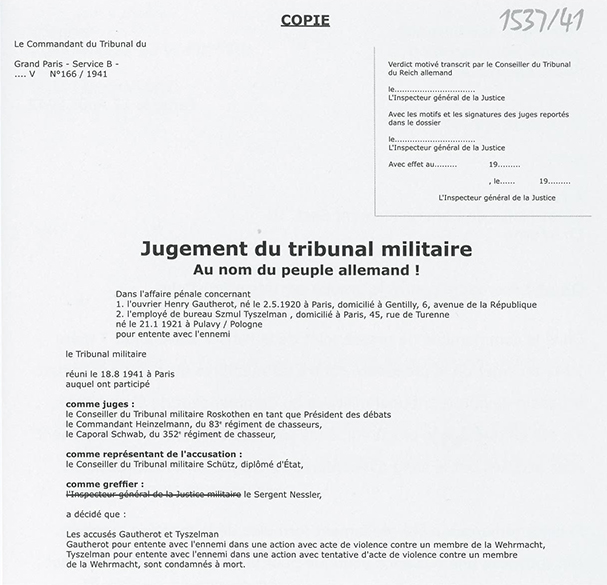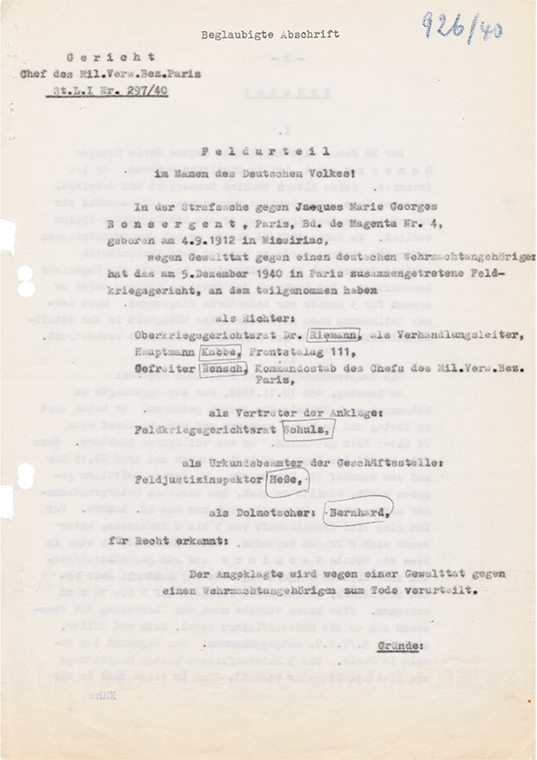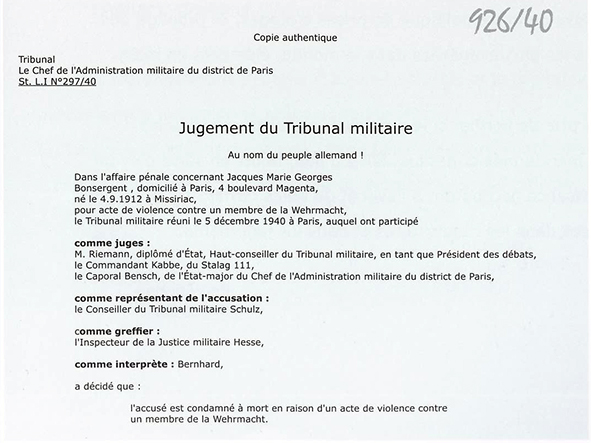In the name of the German people !

The German military tribunals constitute one of the primary instruments of repression and intimidation in the system of occupation established by the invader in France between 1940 and 1944. Long considered the poor relation in historical research due to the very patchy nature of the sources available, the history of this repression with a legal face has recently benefited from a renewed landscape of archives.
While the files of the Wehrmacht tribunals conserved in Germany remain incomplete, they are now supplemented by several sources of archives in France. Among the archives of the special services transferred to the Service historique de la défense (SHD, Defence Historical Service) in Vincennes, for example, some 1,480 legal files prepared by the German courts on over 4,000 French people during the Occupation have recently been discovered and inventoried. These files are very valuable, providing a useful supplement to the German legal collections conserved at the National Archives and the SHD's department of archives on victims of contemporary conflicts. An initial inventory shows that these files/proceedings concern types of cases that are under-represented elsewhere: resistance cases, communists in particular, that often gave rise to very heavy sentences and a significant proportion of the files from the Gross-Paris tribunal which, throughout the Occupation, constituted the main judicial centre of the Militärbefehlshaber in Frankreich MBF, the German military command in France).
Setting an example
The emblematic cases on which these files shed new light include that of Jacques Bonsergent (see slideshow), who was the first recorded condemned man to be shot in Paris. Arrested in November 1940 for having deliberately shoved and hit a German soldier on a pavement near the Gare Saint-Lazare, he appeared on 5 December before the Gross-Paris tribunal, which condemned him to death. He was shot on 23 December at the fort of Vincennes. The main documents in the file include the substantiated ruling and several documents that illustrate the key role played by the MBF Otto von Stülpnagel in his execution. It was von Stülpnagel who, based on the increase in acts of violence against German soldiers, recommended that the commander in chief of the army should reject Bonsergent's appeal for mercy, even though the tribunal had taken care to point out that a sentence of imprisonment would have been preferable to capital punishment if the German order of 10 May 1940 had allowed it, as the accused had clearly acted without premeditation. It was also von Stülpnagel who ordered that the sentence be publicised on posters. By giving its implacable judicial repression greater publicity, the MBF strove to make it a showcase for its draconian policy.
Increasingly intense repression
Many of the files also document the hardening of the German attitude and the ideological direction taken by the repression of the Resistance during the summer of 1941. After the USSR's entry into the war, communist activities were classed as crimes of ”contact with the enemy”. The MBF tribunals were ordered to apply what the MBF's command staff called the ”decree against the communists” of 15 August 1941 with the greatest severity. This amounted to requiring them not to take any extenuating circumstances into account in this type of case. This can be seen in the judicial files of Henry Gautherot and Szmul Tyszelman, two leaders of the clandestine communist youth and members of the youth battalions. Responsible for hideouts and equipment, they were condemned to death on 18 August 1941 by the Gross-Paris tribunal and shot the following day for having taken part in a protest on 13 August organised by the clandestine leadership of the communist youth organisation (see slideshow). Claiming that Szmul Tyszelman's Jewishness suggested that despite his denials he was on the route of the communist protest deliberately, judge Ernst Roskothen justified his decision on the basis of the renewed resistance ”under the Gaullist and Russian-Soviet influence”, which now made it impossible to take this kind of protest lightly. Such protests were just as dangerous as acts of sabotage, espionage and contact with the enemy more broadly. The exemplary nature of the sentences and the intimidatory effect in a context of increasing tension in occupied France were arguments used to legitimise this implacable justice, based solely on the most severe articles of German criminal law.
Once again, it was the MBF who demanded that the sentence be publicised in an opinion which, emphasising Tyszelman's Jewish origins, was designed to give credence to the idea that anti-German actions must be due to Judeo-Bolshevism. An analysis of the German judicial files transferred by the Direction générale de la sécurité extérieure (DGSE, Directorate General of External Security) to the SHD will give us a better grasp of the history of German judicial repression in occupied France, even if we might wonder about the incompleteness of some of them, including the so-called ”Maison de la Chimie” and ”Affiche rouge” trials.
Gaël Eismann
Lecturer in contemporary history at the University of Caen Basse-Normandie,
Quantitative History Research Centre (CRHQ)
FOR MORE INFORMATION
The files are referenced with the following record numbers: Henri Gautherot and Szmul Tyszelman (GR 16 P 247185 et GR 28 P 8 42/21), Jacques Bonsergent (GR 28 P 8 43/28).

Jugement contre Henry Gautherot et Szmul Tyszelman, 18 août 1941 (extrait).
© SHD

Jugement contre Henry Gautherot et Szmul Tyszelman, 18 août 1941 (extrait-traduction).
© SHD

Jugement contre Jacques Marie Georges Bonsergent, 5 décembre 1940 (extrait).
© SHD


